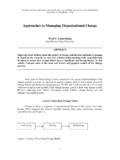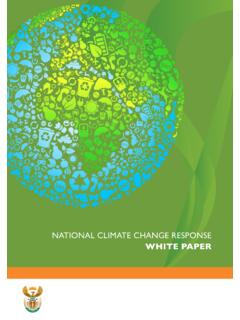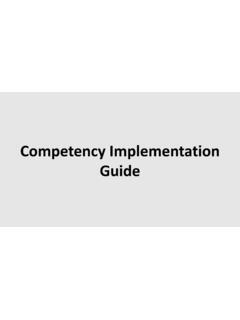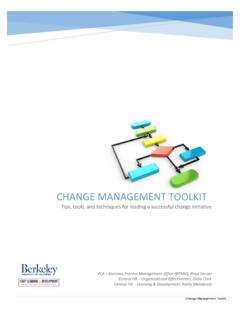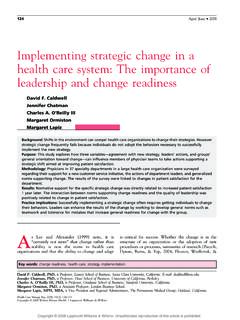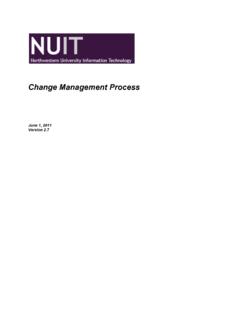Transcription of Forces of change: The Future of Work - Deloitte
1 Forces of change : The Future of WorkA Deloitte series on Future of WorkThe workforce and technology are changing. They are more digital, more technological, and more global. At the same time, business expectations, needs, and demands are evolving faster than ever before. Deloitte is leading our clients into a contingent, crowdsourced, automated, and cog-nitive-enabled Future where the workforce will become increasingly augmented. The Future of Work program is developing and incubating solutions hand in hand with clients around the world, reimagining the Future of talent acquisition, workforce planning, professions, and more. What is our view of the Future of work? | 2 Why does the Future of work matter? | 4 The alternative worker: Off campus and off balance sheetsShifting demographics: Workforce supply changesReengineering work: Technology transforms jobsWhat are the impacts of the Future of work? | 8 Implications for policy makers Implications for organizationsImplications for individuals What should you do next?
2 | 10 Endnotes | 11 CONTENTSThe Future of Work 1 TECHNOLOGICAL advances, demographic shifts, and consumer pulls seem to be funda-mentally changing the way people work and the way organizations design jobs and environ-ments. Some see this as a challenge, but it can be an opportunity to reimagine talent models, organiza-tional practices, and business models. It can be an opportunity to evolve. successfully navigating the coming transforma-tion of work likely requires a refreshed and holistic conversation. We should ask, what will the Future workforce look like? How will we redesign jobs and work? Where will work happen? How will business-es operate under the new realities of work? Address-ing these questions should start with understanding how these Future of work Forces technology, shift-ing demographics, and empowered global custom-ers interact, not as separate threads, but as part of an integrated fabric.
3 We should bring together the agendas of individuals, organizations, and societal ecosystems to redefine our workforces and work-places in ways that not only enhance productivity, but also allow people to thrive in the new realities of work (see figure 1). The Future of work is coming. In some organiza-tions and in parts of many businesses, it is already here. Some are painting a picture out of a science fiction movie, foreseeing doom as robots take over our workplaces. Others suggest that nearly 50 per-cent of jobs will be automated in the coming years, with human workers made redundant by artificial intelligence and What is our view of the Future of work?The Future of work signifies the opportunity to evolve our workforces and work-places. This evolution is being shaped by two powerful Forces : the growing adop-tion of artificial intelligence in the workplace, and the expansion of the workforce to include both on- and off-balance-sheet talent, often referred to as the open talent continuum.
4 These shifts could lead us to reconsider the roles of individuals, organizations, and societies at work. From the individual nine-to-five workday to how entire industries function, work seems to be changing faster than ever. Big shifts threaten to create massive societal and economic disruption unless we look seriously at making the Future of work productive and rewarding for everyone. Within this article, we will unpack how technology could transform the workforce and the way people work in the Future , while also showing how individuals, orga-nizations, and societies can come together to thrive in the new realities at of change2 Will human workers be able to find jobs in the Future ? We believe so. But for many of us, our jobs will likely change . And in some cases, sooner rather than expect to be able to find good jobs with greater capacity for creativity and problem-solving: a Future of work in which humans and machines work together to help find solutions for many of our organizations most pressing problems.
5 Human and machine intelligence can be considered different in complementary, rather than conflicting ways. While they might solve the same problems, they often ap-proach these problems from different It won t be humans vs. machines, but about finding the right combination. However, this could pose unique challenges and opportunities for the way we think through today s work and workforces. This new era will likely lead to a new set of rules and the work, workforce, and workplace of tomorrow could be very different to today s. Within this article, we explore how technology could transform the work-force and the way people work in the Future , while also showing how individuals, organizations, and societies can come together to thrive in the new re-alities at Insights | : Deloitte of change1. Technology: AI, robotics, sensors, and data2. Demographics: Longer lives, growth of younger and older populations, and greater diversity3.
6 The power of pull: Customer empowerment and the rise of global talent marketsImplicationsfor organizations1. Redesign work for technology and learning2. Source and integrate talent across networks3. implement new models of organizational structure, leadership, culture, and rewardsImplications forpublic policy1. Reimagine lifelong education2. Transition support for income and health care3. Reassess legal and regulatory policiesImplicationsfor individuals1. Engage in lifelong learning2. Shape your own career path3. Pursue your passionWork and workforces redefined1. Reengineering work: Technology reshapes every job2. Transforming the workforce: The growth of alternative work arrangementsFigure 1. A framework for understanding the Future of workThe Future of Work 3 THE Future of work is all about people the way they work, where they work, and even who is at work and the way technology is driving change . However, there is a large relational shift occurring between people and their work.
7 Thomas Friedman describes it: Work is being disconnected from jobs, and jobs and work are being disconnected from companies, which are increasingly becoming platforms. A great example of this is what s happening in the cab busi-ness. Traditional local cab companies own cars and have employees who have a job; they drive those cars. But, now they re competing with Uber, which owns no cars, has no employees, and just provides a platform of work that brings together ride-needers and ride-providers. 3 Technology is shifting how we think about the workforce. There are two important changes that seem to be happening in the workforce: one, the worker is moving off campus and off balance sheets, and two, the workforce is aging, more diverse, and educated. While these shifts will likely bring chal-lenges as the workforce transitions, they could evolve workforces to create and capture more value by reinventing work through essentially human learning and alternative worker: Off campus and off balance sheetsTechnology enables the proximity of work to ex-pand beyond a company s walls and balance sheets.
8 The alternative worker is one of the fastest-growing segments of the workforce. The National Bureau of Economic Research found that between 2005 and 2015, approximately 94 percent of net new employ-ment in the United States occurred within the al-ternative work arrangement including everything from gig to freelance and off-balance sheet And this number is anticipated to keep grow-ing. By 2020, an Intuit report predicts that nearly 40 percent of all US workers will be engaged in some sort of alternative work Within our research, we have identified four segments of work arrangements that each possess their own unique needs. Figure 2 shows how the workforce can be segmented along two axes: loca-tion on- vs. off campus, and contract type on- vs. off balance Each of these worker segments represents an opportunity to capture value and diversity across organizations.
9 However, each seg-ment also offers a challenge to incorporate broadly into a company s new relationship between workers and or-ganizations is likely going to present unique chal-lenges, but also opportunities for both individuals and companies to evolve. As the alternative worker shifts to more rapidly evolving work, the way that work is done is likely to change , moving from short-term transactional remote worker to longer-term relationships that help to accelerate learning and performance improvement. The more creative al-ternative work becomes, the more likely it will rely on small teams or work groups that would collabo-rate on different projects over extended periods of does the Future of work matter? Forces of change4 Shifting demographics: Workforce supply changesThe supply of workers is rapidly evolving glob-ally as a result of shifting demographics, enhanced longevity, and increased focus on the inclusion of the marginalized segments of the population.
10 This brings an opportunity for organizations to leverage the most diverse labor market to date. 1. The US workforce is aging and will continue to age. 70 is the new 50 in the Future of work. While Millennials are the largest generational cohort in the market, we project workers over the age of 65 as the fastest-growing worker segment. 2. The US workforce is more diverse. Changing policies are drawing in more diverse populations into organizations. We are seeing a more diverse workforce by gender, ethnicity, culture, religion, and sexual preference and identification than ever Americans continue to become more educated. More and more young people are going to col-lege, and many workers are increasingly trying to improve their educational background could say that tomorrow s workers will be much like today s, but only more so. And the chal-lenges, and benefits of an aging, diverse, and edu-cated workforce, many of which are already evident, will likely only grow in the Deloitte Insights | : Deloitte (at headquarters or satellite locations)Off-campusOn-balancesheetOff-b alancesheetTraditional worker Culture can be absorbed through direct observation Costly to maintain Relatively homogenous environmentOutside contractor Outsider mentality Often lacks formal onboarding and training Typically hired for project-based workTenured remote worker Lacks ability to observe social norms in person Isolated from headquarters Relies heavily on digital communicationsTransactional remote worker Low-quality touch points Often interacts with employer through an app or third-party platform Can have high interaction with customers and/or with traditional employees without significant oversightHybridFigure 2.











